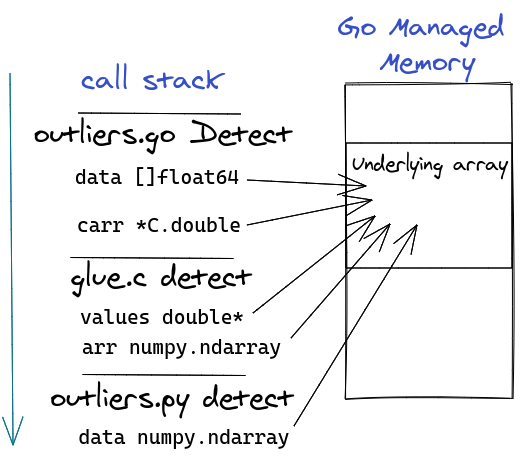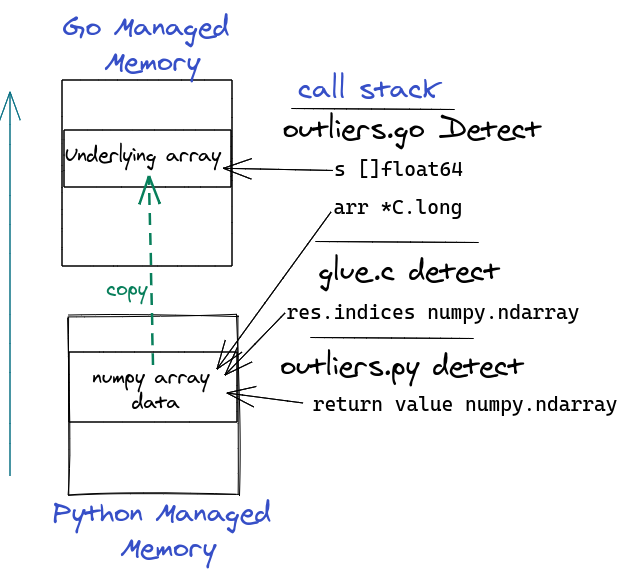Series Index
Python and Go: Part I - gRPC
Python and Go: Part II - Extending Python With Go
Python and Go: Part III - Packaging Python Code
Python and Go: Part IV - Using Python in Memory
Introduction
In a previous post we used gRPC to call Python code from Go. gRPC is a great framework, but there is a performance cost to it. Every function call needs to marshal the arguments using protobuf, make a network call over HTTP/2, and then un-marshal the result using protobuf.
In this blog post, we’ll get rid of the networking layer and to some extent, the marshalling. We’ll do this by using cgo to interact with Python as a shared library.
I’m not going to cover all of the code in detail in order to keep this blog size down. You can find all the code on github and I did my best to provide proper documentation. Feel free to reach out and ask me questions if you don’t understand something.
And finally, if you want to follow along, you’ll need to install the following (apart from Go):
- Python 3.8
- numpy
- A C compiler (such as gcc)
A Crash Course in Python Internals
The version of Python most of us use is called CPython. It’s written in C and is designed to be extended and embedded using C. In this section, we’ll cover some topics that will help you understand the code I’m going to show.
Note: The Python C API is well documented, and there’s even a book in the works.
In CPython, every value is a PyObject * and most of Python’s API functions will return a PyObject * or will receive a PyObject * as an argument. Also, errors are signaled by returning NULL, and you can use the PyErr_Occurred function to get the last exception raised.
CPython uses a reference counting garbage collector which means that every PyObject * has a counter for how many variables are referencing it. Once the reference counter reaches 0, Python frees the object’s memory. As a programmer, you need to take care to decrement the reference counter using the Py_DECREF C macro once you’re done with an object.
From Go to Python and Back Again
Our code tries to minimize memory allocations and avoid unnecessary serialization. In order to do this, we will share memory between Go and Python instead of allocating new memory and copying that data on each side of the function call and return. Sharing memory between two runtimes is tricky and you need to pay a lot of attention to who owns what piece of memory and when each runtime is allowed to release it.
Figure 1
Figure 1 shows the flow of data from the Go function to the Python function.
Our input is a Go slice ([]float64) which has an underlying array in memory managed by Go. We will pass a pointer to the slice’s underlying array to C, which in turn will create a numpy array that will use the same underlying array in memory. It’s this numpy array that will be passed as input to the Python outliers detection function called detect.
Figure 2
Figure 2 shows the flow of data from the Python function back to the Go function.
When the Python detect function completes, it returns a new numpy array whose underlying memory is allocated and managed by Python. Like we did between Go and Python, we will share the memory back to Go by passing the Python pointer to the underlying numpy array (via C).
In order to simplify memory management, on the Go side once we have access to the numpy array pointer, we create a new Go slice ([]int) and copy the content of the numpy array inside.. Then we tell Python it can free the memory it allocated for the numpy array.
After the call to detect completes, the only memory we are left with is the input ([]float64) and the output ([]int) slices both being managed by Go. Any Python memory allocations should be released.
Code Overview
Our Go code is going to load and initialize a Python shared library so it can call the detect function that uses numpy to perform outlier detection on a series of floating point values.
These are the steps that we will follow:
- Convert the Go slice
[]float64parameter to a Cdouble *(outliers.go) - Create a numpy array from the C
double *(glue.c) - Call the Python function with the numpy array (
glue.c) - Get back a numpy array with indices of outliers (
glue.c) - Extract C
long *from the numpy array (glue.c) - Convert the C
long *to a Go slice[]intand return it from the Go function (outliers.go)
The Go code is in outliers.go, there’s some C code in glue.c, and finally the outlier detection Python function is in outliers.py. I’m not going to show the C code, but if you’re curious about it have a look at glue.c.
Listing 1: Example Usage
15 o, err := NewOutliers("outliers", "detect")
16 if err != nil {
17 return err
18 }
19 defer o.Close()
20 indices, err := o.Detect(data)
21 if err != nil {
22 return err
23 }
24 fmt.Printf("outliers at: %v\n", indices)
25 return nil
Listing 1 shows an example of how to use what we’re going to build in Go. On line 15, we create an Outliers object which uses the function detect from the outliers Python module. On line 19, we make sure to free the Python object. On line 20, we call the Detect method and get the indices of the outliers in the data.
Code Highlights
Listing 2: outliers.go [code]
19 var (
20 initOnce sync.Once
21 initErr error
22 )
23
24 // initialize Python & numpy, idempotent
25 func initialize() {
26 initOnce.Do(func() {
27 C.init_python()
28 initErr = pyLastError()
29 })
30 }
Listing 2 shows how we initialize Python for use in our Go program. On line 20, we declare a variable of type sync.Once that will be used to make sure we initialize Python only once. On line 25, we create a function to initialize Python. On line 26, we call the Do method to call the initialization code and on line 28, we set the initErr variable to the last Python error.
Listing 3: outliers.go [code]
32 // Outliers does outlier detection
33 type Outliers struct {
34 fn *C.PyObject // Outlier detection Python function object
35 }
Listing 3 shows the definition of the Outliers struct. It has one field on line 34 which is a pointer to the Python function object that does the actual outlier detection.
Listing 4: outliers.go [code]
37 // NewOutliers returns an new Outliers using moduleName.funcName Python function
38 func NewOutliers(moduleName, funcName string) (*Outliers, error) {
39 initialize()
40 if initErr != nil {
41 return nil, initErr
42 }
43
44 fn, err := loadPyFunc(moduleName, funcName)
45 if err != nil {
46 return nil, err
47 }
48
49 return &Outliers{fn}, nil
50 }
Listing 4 shows the NewOutliers function that created an Outliers struct. On lines 39-42, we make sure Python is initialized and there’s no error. On line 44, we get a pointer to the Python detect function. This is the same as doing an import statement in Python. On line 49, we save this Python pointer for later use in the Outliers struct.
Listing 5: outliers.go [code]
52 // Detect returns slice of outliers indices
53 func (o *Outliers) Detect(data []float64) ([]int, error) {
54 if o.fn == nil {
55 return nil, fmt.Errorf("closed")
56 }
57
58 if len(data) == 0 { // Short path
59 return nil, nil
60 }
61
62 // Convert []float64 to C double*
63 carr := (*C.double)(&(data[0]))
64 res := C.detect(o.fn, carr, (C.long)(len(data)))
65
66 // Tell Go's GC to keep data alive until here
67 runtime.KeepAlive(data)
68 if res.err != 0 {
69 return nil, pyLastError()
70 }
71
72 indices, err := cArrToSlice(res.indices, res.size)
73 if err != nil {
74 return nil, err
75 }
76
77 // Free Python array object
78 C.py_decref(res.obj)
79 return indices, nil
80 }
Listing 5 shows the code for the Outliers.Detect method. On line 63, we convert Go’s []float64 slice to a C double * by taking the address of the first element in the underlying slice value. On line 64, we call the Python detect function via CGO and we get back a result. On line 67, we tell Go’s garbage collector that it can’t reclaim the memory for data before this point in the program. On lines 68-70, we check if there was an error calling detect. On lines 72, we convert the C double * to a Go []int slice. On line 79, we decrement the Python return value reference count.
Listing 6: outliers.go [code]
82 // Close frees the underlying Python function
83 // You can't use the object after closing it
84 func (o *Outliers) Close() {
85 if o.fn == nil {
86 return
87 }
88 C.py_decref(o.fn)
89 o.fn = nil
90 }
Listing 6 shows the Outliers.Close method. On line 88, we decrement the Python function object reference count and on line 89, we set the fn field to nil to signal the Outliers object is closed.
Building
The glue code is using header files from Python and numpy. In order to build, we need to tell cgo where to find these header files.
Listing 7: outliers.go [code]
11 /*
12 #cgo pkg-config: python3
13 #cgo LDFLAGS: -lpython3.8
14
15 #include "glue.h"
16 */
17 import "C"
Listing 7 shows the cgo directives.
On line 12, we use pkg-config to find C compiler directives for Python. On line 13, we tell cgo to use the Python 3.8 shared library. On line 15, we import the C code definitions from glue.h and on line 17, we have the import "C" directive that must come right after the comment for using cgo.
Telling cgo where to find the numpy headers is tricky since numpy doesn’t come with a pkg-config file, but has a Python function that will tell you where the headers are. For security reasons, cgo won’t run arbitrary commands. I opted to ask the user to set the CGO_CFLAGS environment variable before building or installing the package.
Listing 8: Build commands
01 $ export CGO_CFLAGS="-I $(python -c 'import numpy; print(numpy.get_include())'"
02 $ go build
Listing 8 shows how to build the package. On line 01, we set CGO_CFLAGS to a value printed from a short Python program that prints the location of the numpy header files. On line 02, we build the package.
I like to use make to automate such tasks. Have a look at the Makefile to learn more.
Conclusion
I’d like to start by thanking the awesome people at the (aptly named) #darkarts channel in Gophers Slack for their help and insights.
The code we wrote here is tricky and error prone so you should have some tight performance goals before going down this path. Benchmarking on my machine shows this code is about 45 times faster than the equivalent gRPC code code, the function call overhead (without the outliers calculation time) is about 237 times faster. Even though I’m programming in Go for 10 years and in Python close to 25 - I learned some new things.





